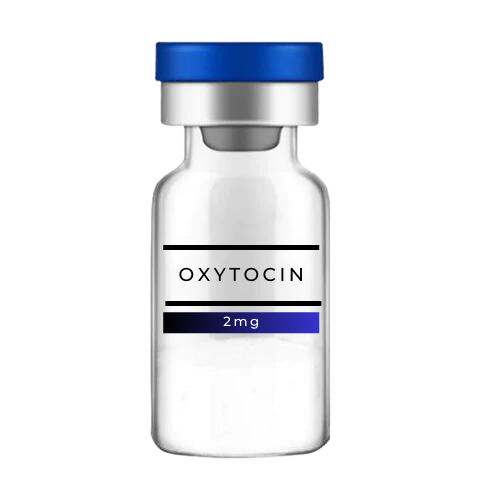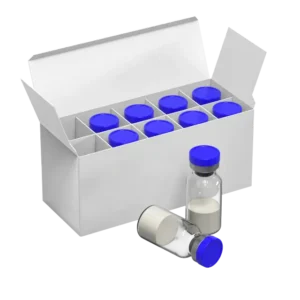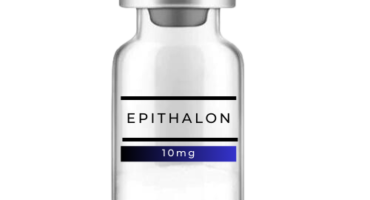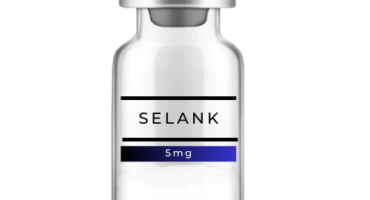Oxytocin is produced in the hypothalamus and is secreted into the bloodstream by the posterior pituitary gland. Secretion depends on the electrical activity of neurons in the hypothalamus – it is released into the blood when these cells are excited.
The two main actions of oxytocin in the body are contraction of the womb (uterus) during childbirth and lactation. Oxytocin stimulates the uterine muscles to contract and also increases the production of prostaglandins, which increase the contractions further. Manufactured oxytocin is sometimes given to induce labor if it has not started naturally or it can be used to strengthen contractions to aid childbirth. In addition, manufactured oxytocin is often given to speed up delivery of the placenta and reduce the risk of heavy bleeding by contracting the uterus. During breastfeeding, oxytocin promotes the movement of milk through the ducts in the breast, allowing it to be excreted by the nipple. Oxytocin is also present in men, playing a role in sperm transport and the production of testosterone by the testes.
In the brain, oxytocin acts as a chemical messenger and has an important role in many human behaviors
Oxytocin
Oxytocin is a hormone that acts on organs in the body (including the breast and uterus) and as a chemical messenger in the brain, controlling key aspects of the reproductive system, including childbirth and lactation, and aspects of human behavior.
Alternative names for oxytocin
Alpha-hypophagia; manufactured versions – syntocinon and pitocin (both synthetic oxytocin); carbetocin (an analog of oxytocin with a similar structure)
What is oxytocin?
Oxytocin is produced in the hypothalamus and is secreted into the bloodstream by the posterior pituitary gland. Secretion depends on the electrical activity of neurons in the hypothalamus – it is released into the blood when these cells are excited.
The two main actions of oxytocin in the body are contraction of the womb (uterus) during childbirth and lactation. Oxytocin stimulates the uterine muscles to contract and also increases the production of prostaglandins, which increase the contractions further. Manufactured oxytocin is sometimes given to induce labor if it has not started naturally or it can be used to strengthen contractions to aid childbirth. In addition, manufactured oxytocin is often given to speed up delivery of the placenta and reduce the risk of heavy bleeding by contracting the uterus. During breastfeeding, oxytocin promotes the movement of milk through the ducts in the breast, allowing it to be excreted by the nipple. Oxytocin is also present in men, playing a role in sperm transport and the production of testosterone by the testes.
In the brain, oxytocin acts as a chemical messenger and has an important role in many human behaviors including sexual arousal, recognition, trust, romantic attachment, and mother–infant bonding. As a result, oxytocin has been called the ‘love hormone’ or ‘cuddle chemical’.
The effect of oxytocin on the brain is complex. Current research is focused on examining the role of oxytocin in various disorders including addiction, depression, post-traumatic stress, anxiety, and anorexia.
How is oxytocin controlled?
Oxytocin production and secretion are controlled by a positive feedback mechanism where the release of the hormone causes an action that stimulates more of its own release. For example, when contraction of the uterus starts during childbirth, oxytocin is released. This stimulates more contractions and more oxytocin is released. In this way, contractions increase in intensity and frequency.
There is also positive feedback involved in the milk-ejection reflex. Stimulation of the nipple during breastfeeding leads to increased oxytocin production and secretion into the blood, which then causes milk to be let down into the breast. The positive feedback cycle is maintained until the baby stops suckling. The production of oxytocin during childbirth is also self-limiting; the release of the hormone is stopped once the baby is delivered.
What happens if I have too much oxytocin?
At present, the implications of having too much oxytocin are not clear. High levels have been linked to benign prostatic hyperplasia, a condition that affects the prostate in more than half of men over the age of 60. This may cause difficulty in passing urine.
It may be possible to treat this condition by manipulating oxytocin levels; however, more research is needed before any possible treatments are available.
What happens if I have too little oxytocin?
Similarly, it is not fully understood at present if there are any implications of having too little oxytocin in the body. A lack of oxytocin in a nursing mother would prevent the milk-ejection reflex and prevent breastfeeding.
Low oxytocin levels have been linked to autism and autistic spectrum disorders (e.g. Asperger syndrome) – a key element of these disorders being poor social functioning. Some scientists believe oxytocin could be used to treat these disorders. In addition, low oxytocin has been linked to depressive symptoms and it has been proposed as a treatment for depressive disorders. However, there is not enough evidence at present to support its use for any of these conditions.
*Vial top color may vary.
| Weight | 1 lbs |
|---|---|
| Dimensions | 1 × 1 × 1 in |
| MG | 20mg – 2mg vials x 10 |





